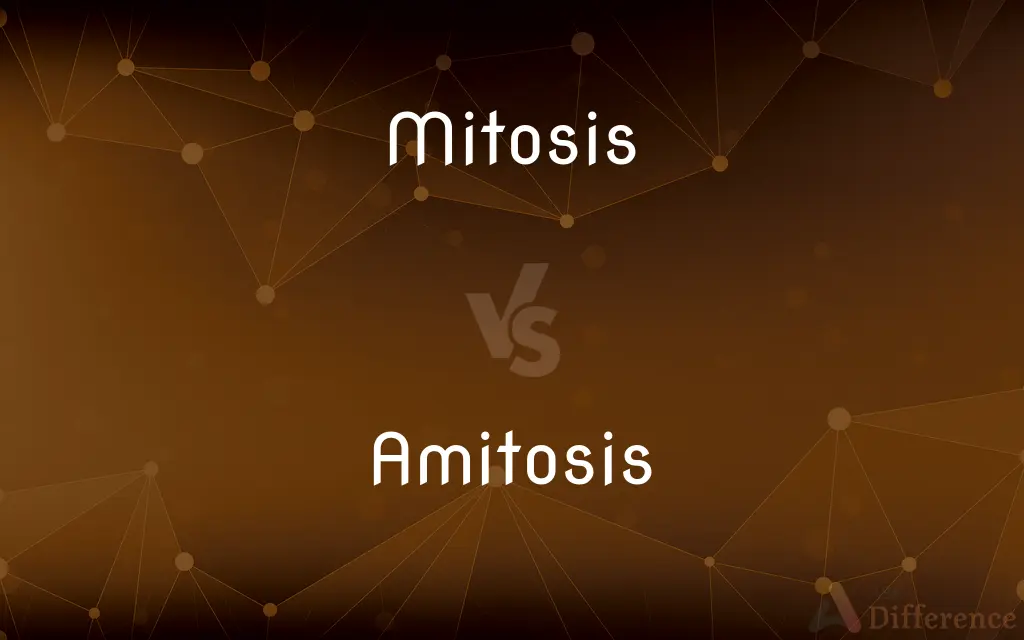Mitosis vs. Amitosis — What's the Difference?
By Fiza Rafique & Urooj Arif — Updated on March 30, 2024
Mitosis is a complex process of cell division resulting in two genetically identical daughter cells, involving distinct phases, while amitosis is a simpler form of cell division, producing two cells without the typical stages of mitosis.

Difference Between Mitosis and Amitosis
Table of Contents
ADVERTISEMENT
Key Differences
Mitosis is characterized by a series of organized steps: prophase, metaphase, anaphase, and telophase, ensuring accurate genetic replication and distribution. Whereas, amitosis lacks these structured phases, typically involving direct splitting of the nucleus and cytoplasm, resulting in a less regulated division process.
In mitosis, the genetic material is precisely duplicated and equally allocated to the daughter cells, preserving genetic consistency across cell generations. On the other hand, amitosis often results in unequal distribution of genetic material, which may lead to genetic variation or loss of genetic material in the daughter cells.
Mitosis is commonly found in eukaryotic organisms, where it plays a crucial role in growth, repair, and reproduction. Amitosis, however, is mostly observed in prokaryotes, certain unicellular eukaryotes, and some specialized cells, serving as a quicker, albeit less precise, method of reproduction.
The mitotic process includes the breakdown and reformation of the nuclear envelope, ensuring the chromosomes are correctly partitioned. Conversely, in amitosis, the nuclear envelope often remains intact or partially forms around the dividing genetic material, which can lead to a range of nuclear shapes and sizes in the daughter cells.
While mitosis involves the formation of a mitotic spindle to separate chromosomes, amitosis typically does not involve such complex machinery for chromosome separation. This absence contributes to the unequal segregation of genetic material during amitosis.
ADVERTISEMENT
Comparison Chart
Definition
A type of cell division resulting in two genetically identical daughter cells.
A simpler form of cell division without typical mitotic phases.
Phases
Involves prophase, metaphase, anaphase, and telophase.
Lacks organized phases, with direct splitting of the nucleus.
Genetic Material Distribution
Equal distribution of genetic material.
Often results in unequal distribution of genetic material.
Occurrence
Common in eukaryotic organisms for growth, repair, and reproduction.
Mostly in prokaryotes and some unicellular eukaryotes.
Nuclear Envelope
Breakdown and reformation occur during the process.
Often remains intact, leading to varied nuclear shapes.
Machinery
Involves mitotic spindle for chromosome separation.
Lacks complex machinery for chromosome separation.
Compare with Definitions
Mitosis
Spindle formation.
The mitotic spindle plays a key role in chromosome separation during mitosis.
Amitosis
Prokaryotic division.
Amitosis is often observed in prokaryotic organisms and some unicellular eukaryotes.
Mitosis
Distinct phases.
During mitosis, cells undergo distinct phases for precise genetic separation.
Amitosis
Varied nuclear shapes.
Amitosis can result in daughter cells with varied nuclear shapes due to the division process.
Mitosis
Cell replication.
Mitosis ensures each daughter cell receives an exact copy of the parent's genetic material.
Amitosis
Genetic variation.
Amitosis can lead to genetic variation due to unequal distribution of genetic material.
Mitosis
Genetic consistency.
Mitosis maintains genetic consistency across generations of cells.
Amitosis
Simple division.
Amitosis involves the direct splitting of a cell's nucleus and cytoplasm.
Mitosis
Eukaryotic process.
Mitosis is a critical process for eukaryotic cell division and tissue growth.
Amitosis
Quick reproduction.
Amitosis allows for quick reproduction in certain cells without complex division phases.
Mitosis
In cell biology, mitosis () is a part of the cell cycle in which replicated chromosomes are separated into two new nuclei. Cell division gives rise to genetically identical cells in which the total number of chromosomes is maintained.
Amitosis
Amitosis (a- + mitosis), also called 'karyostenosis' or direct cell division or binary fission. It is cell proliferation that does not occur by mitosis, the mechanism usually identified as essential for cell division in eukaryotes.
Mitosis
A type of cell division that results in two daughter cells each having the same number and kind of chromosomes as the parent nucleus, typical of ordinary tissue growth
The single large egg cell subdivides by repeated mitosis
Each mitosis seems to be associated with an increase in calcium
Amitosis
Direct cell division by simple cleavage of the nucleus, without spindle formation or the appearance of chromosomes.
Mitosis
The process in cell division by which the nucleus divides, typically consisting of four stages, prophase, metaphase, anaphase, and telophase, and normally resulting in two new nuclei, each of which contains a complete copy of the parental chromosomes.Also called karyokinesis.
Amitosis
Cell division by cleavage of the nucleus without the formation of condensed chromosomes
Mitosis
The entire process of cell division including division of the nucleus and the cytoplasm.
Amitosis
Cell division in which there is first a simple cleavage of the nucleus without change in its structure (such as the formation of chromosomes), followed by the division of the cytoplasm; direct cell division; - opposed to mitosis. It is not the usual mode of division, and is believed by many to occur chiefly in highly specialized cells which are incapable of long-continued multiplication, in transitory structures, and in those in early stages of degeneration.
Mitosis
(cytology) The division of a cell nucleus in which the genome is copied and separated into two identical halves. It is normally followed by cell division.
Amitosis
The direct method of cell division characterized by simple division of the nucleus without formation of chromosomes
Mitosis
See Karyokinesis.
Mitosis
Cell division in which the nucleus divides into nuclei containing the same number of chromosomes
Common Curiosities
How does amitosis contribute to genetic variation?
The unequal distribution of genetic material during amitosis can lead to variations or mutations in the daughter cells.
Why might a cell undergo amitosis instead of mitosis?
Amitosis is quicker and requires less energy, beneficial for certain prokaryotes and specialized eukaryotic cells in specific conditions.
How does the nuclear envelope behave differently in mitosis and amitosis?
In mitosis, the nuclear envelope disassembles and reassembles, while in amitosis, it may remain intact, affecting division.
What is the main difference between mitosis and amitosis?
Mitosis involves a series of organized phases for precise genetic duplication, while amitosis is a simpler division without such phases.
Can mitosis occur in prokaryotic cells?
No, prokaryotic cells typically divide by binary fission, a process different from mitosis.
How do the products of mitosis and amitosis differ?
Mitosis produces genetically identical daughter cells, while amitosis may result in cells with varied amounts of genetic material.
Can amitosis lead to genetic disorders?
Yes, the unequal division of genetic material in amitosis can potentially lead to genetic anomalies or disorders.
Can environmental factors influence whether a cell undergoes mitosis or amitosis?
Yes, environmental conditions, such as nutrient availability and stress, can influence cell division choices.
Is amitosis common in multicellular organisms?
No, amitosis is rare in multicellular organisms and more common in prokaryotes and some unicellular eukaryotes.
How does the mitotic spindle function in mitosis?
It helps separate chromosomes into daughter cells, ensuring accurate genetic duplication.
Is there any situation where a eukaryotic cell might prefer amitosis?
In some specialized situations, like certain types of cell repair or adaptation, eukaryotic cells might utilize mechanisms similar to amitosis.
What role does cell size play in the choice between mitosis and amitosis?
Cell size can influence division; smaller cells or those requiring rapid division might favor amitosis for its simplicity and speed.
How are mitosis and amitosis studied in the laboratory?
Through microscopy and genetic analysis, researchers can observe and compare the processes and outcomes of mitosis and amitosis.
How do advancements in biology impact our understanding of mitosis and amitosis?
Advances in molecular biology and genetics continue to deepen our understanding of these processes, including their regulation and variations across organisms.
Share Your Discovery

Previous Comparison
Fact vs. Opinion
Next Comparison
ABS vs. PVCAuthor Spotlight
Written by
Fiza RafiqueFiza Rafique is a skilled content writer at AskDifference.com, where she meticulously refines and enhances written pieces. Drawing from her vast editorial expertise, Fiza ensures clarity, accuracy, and precision in every article. Passionate about language, she continually seeks to elevate the quality of content for readers worldwide.
Co-written by
Urooj ArifUrooj is a skilled content writer at Ask Difference, known for her exceptional ability to simplify complex topics into engaging and informative content. With a passion for research and a flair for clear, concise writing, she consistently delivers articles that resonate with our diverse audience.














































